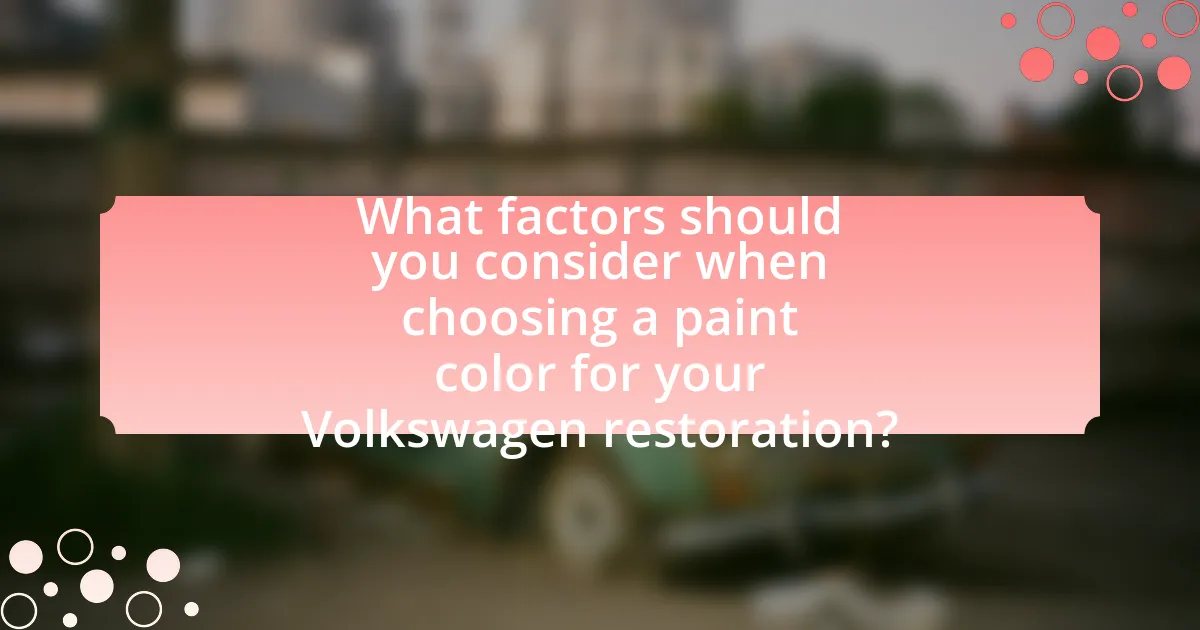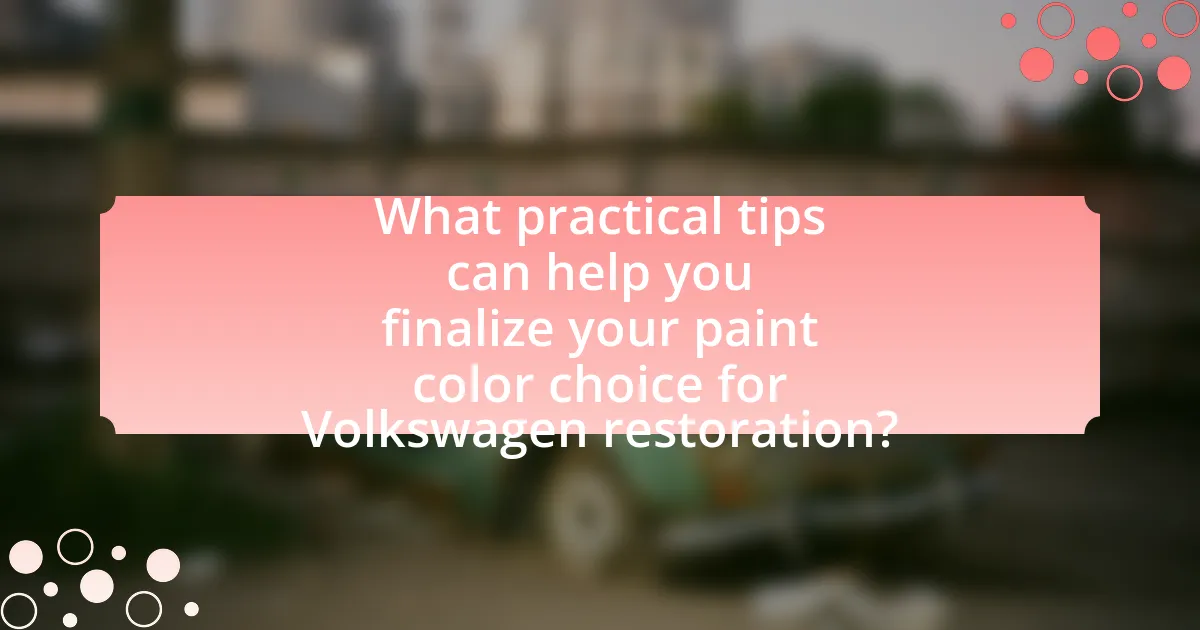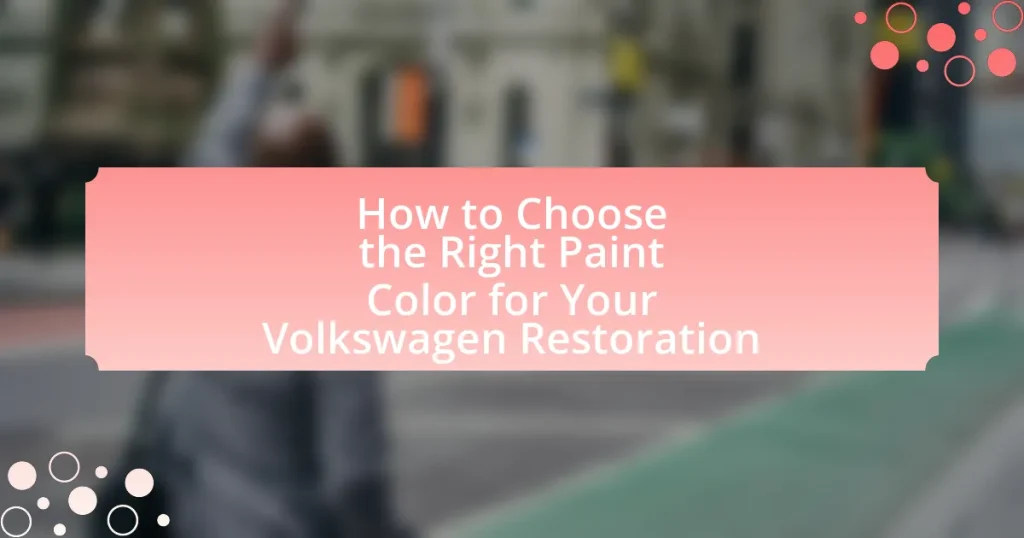The article focuses on selecting the appropriate paint color for Volkswagen restoration, emphasizing the importance of the vehicle’s original color, personal preferences, and intended use. It discusses how the original color affects authenticity and resale value, while also exploring the influence of model and year on color selection. Additionally, the article examines various paint finishes, the benefits of custom paint options, and practical tips for finalizing color choices, including testing colors under different lighting conditions and avoiding common mistakes. Resources for color inspiration and guidance are also provided to assist restorers in making informed decisions.

What factors should you consider when choosing a paint color for your Volkswagen restoration?
When choosing a paint color for your Volkswagen restoration, consider the vehicle’s original color, personal preferences, and the intended use of the vehicle. The original color is significant because it maintains the car’s historical value and authenticity, especially for classic models. Personal preferences play a crucial role, as the color should reflect the owner’s style and vision for the vehicle. Additionally, the intended use, whether for daily driving or show purposes, can influence the choice; brighter colors may stand out more at shows, while neutral tones might be more practical for everyday use.
How does the original color influence your choice?
The original color significantly influences your choice by affecting the vehicle’s perceived value and authenticity. When restoring a Volkswagen, selecting the original color can enhance the car’s resale value, as collectors often prefer vehicles that maintain their factory specifications. According to a study by the Classic Car Club of America, vehicles that are restored to their original color can see a price increase of up to 20% compared to those with non-original colors. This preference for authenticity underscores the importance of the original color in the decision-making process for restorers.
What are the benefits of restoring to the original factory color?
Restoring to the original factory color enhances the vehicle’s value and authenticity. This practice appeals to collectors and enthusiasts who prioritize originality, often resulting in higher resale prices. According to the Hagerty Valuation Tool, vehicles that maintain their factory specifications, including color, can see value increases of up to 20% compared to those with non-original colors. Additionally, using the original color ensures that the restoration aligns with historical accuracy, preserving the vehicle’s heritage and appeal.
How can you find the original color code for your Volkswagen?
To find the original color code for your Volkswagen, locate the Vehicle Identification Number (VIN) plate, which is typically found in the driver’s side door jamb or under the windshield. The color code is often listed on this plate or in the owner’s manual. Additionally, you can check the paint code sticker, usually located in the trunk or under the hood. This information is crucial as it ensures you select the correct paint for restoration, maintaining the vehicle’s authenticity.
What role does the model and year of your Volkswagen play in color selection?
The model and year of your Volkswagen significantly influence color selection due to historical color availability and design trends specific to each model. For instance, classic models like the Beetle from the 1960s had a limited palette, often featuring pastel colors, while newer models may offer a broader range of contemporary shades. Additionally, certain colors may be associated with specific years or models, impacting authenticity in restorations. For example, the 1970 Volkswagen Type 2 was commonly available in colors like “Lemon Yellow” and “Turquoise,” which are now sought after by collectors. Thus, understanding the model and year helps ensure that the chosen color aligns with the vehicle’s original aesthetic and market value.
How do different models have unique color palettes?
Different Volkswagen models have unique color palettes due to their distinct design philosophies and historical contexts. Each model is often associated with specific colors that reflect its era, target market, and brand identity. For instance, the classic Volkswagen Beetle featured pastel colors in the 1960s, appealing to a youthful demographic, while the modern Volkswagen Golf offers a range of contemporary shades that align with current automotive trends. This differentiation in color palettes is supported by Volkswagen’s marketing strategies, which aim to evoke specific emotions and associations with each model, thereby enhancing brand loyalty and consumer appeal.
What are the popular colors for specific Volkswagen models and years?
Popular colors for specific Volkswagen models and years include classic shades like “Lapis Blue” for the 1960s Beetle, “Ravenna Green” for the 1970s Type 2, and “Tornado Red” for the 1980s Golf. These colors have been historically favored due to their aesthetic appeal and cultural significance within the Volkswagen community. For instance, the 1967 Beetle is often associated with “Sea Blue,” while the 1990s Jetta gained popularity in “Black Magic Pearl.” These color trends reflect consumer preferences and the brand’s marketing strategies during those eras.
How do personal preferences impact your color choice?
Personal preferences significantly influence color choice by reflecting individual tastes, emotions, and cultural associations. For instance, a person may prefer vibrant colors like red or yellow due to their associations with energy and excitement, while others might lean towards muted tones like blue or gray for their calming effects. Research indicates that color preferences can be linked to personality traits; for example, extroverted individuals often favor bright colors, while introverted individuals may prefer softer shades. This connection between personal identity and color choice is supported by studies such as “Color Preference and Personality” by Andrew Elliot and Markus Maier, which found that color preferences can serve as an expression of one’s self-concept.
What are the psychological effects of color on vehicle aesthetics?
The psychological effects of color on vehicle aesthetics significantly influence consumer perception and emotional response. For instance, studies show that colors like red evoke feelings of excitement and passion, often associated with sports cars, while blue tends to convey trust and reliability, making it popular for family vehicles. Research by the Institute for Color Research indicates that up to 90% of snap judgments made about products can be based on color alone, highlighting its critical role in vehicle appeal. Additionally, color can affect perceived value; luxury brands often utilize darker, richer colors to enhance sophistication and exclusivity. Thus, the choice of color in vehicle aesthetics not only impacts visual appeal but also shapes consumer emotions and brand associations.
How can you balance personal taste with market trends?
To balance personal taste with market trends in choosing paint colors for Volkswagen restoration, one should conduct thorough market research while also reflecting individual preferences. Analyzing current popular colors in the automotive restoration market, such as classic shades like Volkswagen’s original pastel colors, can provide insight into trends. Simultaneously, incorporating personal favorites or unique color choices can differentiate the restoration project. For instance, a study by the Automotive Color Trends Report indicates that neutral colors remain popular, but vibrant hues can attract attention and enhance resale value. Therefore, blending trending colors with personal style creates a unique yet market-relevant restoration.

What are the different types of paint finishes available for Volkswagen restorations?
The different types of paint finishes available for Volkswagen restorations include gloss, satin, matte, and metallic finishes. Gloss finishes provide a high-shine appearance and are often used for a classic look, while satin finishes offer a softer sheen that balances between gloss and matte. Matte finishes have no shine and create a unique, modern aesthetic, and metallic finishes incorporate metal flakes for a sparkling effect. Each finish serves distinct visual and protective purposes, allowing restorers to achieve their desired look while ensuring durability.
What are the characteristics of matte, gloss, and satin finishes?
Matte finishes are characterized by their non-reflective surface, providing a smooth, muted appearance that hides imperfections well. Gloss finishes, on the other hand, have a shiny, reflective surface that enhances color vibrancy and is easier to clean, but may highlight surface flaws. Satin finishes strike a balance between matte and gloss, offering a soft sheen that provides some reflectivity while still concealing imperfections, making it a popular choice for a sophisticated look. These characteristics are essential in selecting the right finish for a Volkswagen restoration, as they affect both aesthetics and maintenance.
How does each finish affect the appearance of the paint color?
The finish of paint significantly affects the appearance of its color. A glossy finish enhances color vibrancy and depth, reflecting light and making hues appear more saturated. In contrast, a matte finish absorbs light, resulting in a softer, more muted appearance of the color. Satin finishes strike a balance between gloss and matte, providing a subtle sheen that can enhance color richness without overwhelming brightness. The choice of finish can also influence the perception of texture and detail in the paint, impacting the overall aesthetic of the Volkswagen restoration.
What are the maintenance requirements for each type of finish?
The maintenance requirements for each type of finish vary significantly. For a glossy finish, regular washing with mild soap and water is essential to maintain its shine, along with periodic waxing to protect against UV damage. A matte finish requires gentle cleaning with a microfiber cloth to avoid scratches, and it should not be waxed, as this can alter its appearance. Satin finishes need a balance; they should be cleaned with a soft cloth and can benefit from occasional waxing to enhance durability without compromising the sheen. Each finish type demands specific care to preserve its aesthetic and functional qualities, ensuring longevity and visual appeal in a Volkswagen restoration.
How do custom paint options compare to standard colors?
Custom paint options offer greater personalization and uniqueness compared to standard colors, which are typically limited to a predefined palette. Standard colors are mass-produced and readily available, making them more cost-effective and easier to source. In contrast, custom paint options allow for specific shades, finishes, and effects tailored to individual preferences, often resulting in a higher price point and longer lead times. Customization can enhance the aesthetic appeal and value of a Volkswagen restoration, as it reflects the owner’s personal style and can differentiate the vehicle in the market.
What are the pros and cons of custom paint jobs?
Custom paint jobs offer unique personalization and aesthetic appeal, allowing vehicle owners to express their individuality. However, they can also lead to higher costs and potential issues with resale value. The customization process often requires skilled labor, which can increase expenses significantly; for example, a high-quality custom paint job can range from $1,000 to $5,000, depending on complexity and materials used. Additionally, custom paint may not appeal to all buyers, potentially reducing the vehicle’s marketability. Therefore, while custom paint jobs enhance visual appeal and personal expression, they also come with financial and resale considerations.
How can you ensure quality in a custom paint application?
To ensure quality in a custom paint application, it is essential to prepare the surface meticulously, select high-quality paint, and apply it under optimal conditions. Proper surface preparation involves cleaning, sanding, and priming to create a smooth base that enhances adhesion and finish. Using high-quality paint ensures durability and color accuracy, as premium products often contain better pigments and resins. Additionally, applying paint in controlled environments, such as a dust-free area with stable temperature and humidity, minimizes imperfections and promotes an even coat. These practices are supported by industry standards, which emphasize that thorough preparation and quality materials significantly impact the longevity and appearance of the paint job.

What practical tips can help you finalize your paint color choice for Volkswagen restoration?
To finalize your paint color choice for Volkswagen restoration, consider creating a color palette that reflects the vehicle’s original hues or your personal preferences. Start by researching the historical color options available for your specific Volkswagen model, as many classic models have a defined set of factory colors. Utilize paint samples to visualize how different shades look under various lighting conditions, as colors can appear differently in natural light versus artificial light. Additionally, consult with restoration experts or join Volkswagen enthusiast forums to gather insights and recommendations on popular color choices that maintain the vehicle’s authenticity. This approach ensures that your final decision is informed by both historical accuracy and personal taste.
How can you test paint colors before making a final decision?
To test paint colors before making a final decision, apply sample swatches directly on the surface you intend to paint. This method allows you to see how the color interacts with the existing lighting and surroundings. Additionally, using paint samples in various lighting conditions—such as natural light, artificial light, and at different times of the day—provides a comprehensive view of how the color will appear in real-life scenarios. According to the Paint Quality Institute, testing colors in situ can reveal undertones and variations that may not be apparent in small sample cards, ensuring a more accurate selection for your Volkswagen restoration project.
What are the best methods for sampling paint colors on your vehicle?
The best methods for sampling paint colors on your vehicle include using paint swatches, applying test patches, and utilizing digital color matching tools. Paint swatches allow you to see the color in different lighting conditions and against your vehicle’s existing color. Applying test patches directly on the vehicle provides a real-world view of how the color looks on the surface and in various lighting. Digital color matching tools, such as mobile apps or software, can help visualize how different colors will appear on your vehicle by simulating the paint application. These methods are effective because they provide visual references and practical applications, ensuring that the chosen color aligns with your preferences and the vehicle’s aesthetic.
How can lighting conditions affect your perception of color?
Lighting conditions significantly influence your perception of color by altering the way colors are seen and interpreted. Different light sources, such as natural sunlight, incandescent bulbs, or fluorescent lights, emit varying color temperatures that can make the same color appear differently. For example, a paint color may look warmer under incandescent lighting and cooler under fluorescent lighting, affecting the overall aesthetic of a Volkswagen restoration. Studies in color theory indicate that the human eye perceives colors based on the surrounding light spectrum, which can shift hues and intensities, leading to potential mismatches in color selection during restoration projects.
What common mistakes should you avoid when selecting a paint color?
When selecting a paint color, avoid the mistake of choosing a color based solely on trends rather than personal preference or the vehicle’s original color. Trends can quickly change, leading to dissatisfaction over time. Additionally, neglecting to test paint samples in different lighting conditions can result in a color that appears different than expected once applied. It’s also crucial to avoid overlooking the impact of the vehicle’s surroundings; colors that clash with the environment can detract from the overall aesthetic. Lastly, failing to consider the vehicle’s purpose and usage can lead to impractical choices; for example, lighter colors may show dirt more easily on a daily driver.
How can you prevent buyer’s remorse after choosing a color?
To prevent buyer’s remorse after choosing a color, conduct thorough research and visualization before making a final decision. This includes using color swatches, digital tools, or mock-ups to see how the color looks in different lighting and settings. Studies show that visualizing the final outcome can significantly reduce regret, as it aligns expectations with reality. Additionally, gathering feedback from trusted friends or experts can provide reassurance and validate your choice, further minimizing the likelihood of remorse.
What resources are available for color inspiration and guidance?
Color inspiration and guidance for Volkswagen restoration can be found through several key resources. Online platforms such as Pinterest and Instagram offer a wealth of visual examples showcasing various color schemes used in automotive restorations. Additionally, automotive paint manufacturers like PPG and DuPont provide color swatches and digital tools to visualize paint options. Classic car clubs and forums, such as The Samba, also serve as valuable communities where enthusiasts share their restoration experiences and color choices. These resources collectively enable restorers to make informed decisions about color selection, ensuring alignment with historical accuracy and personal preference.


